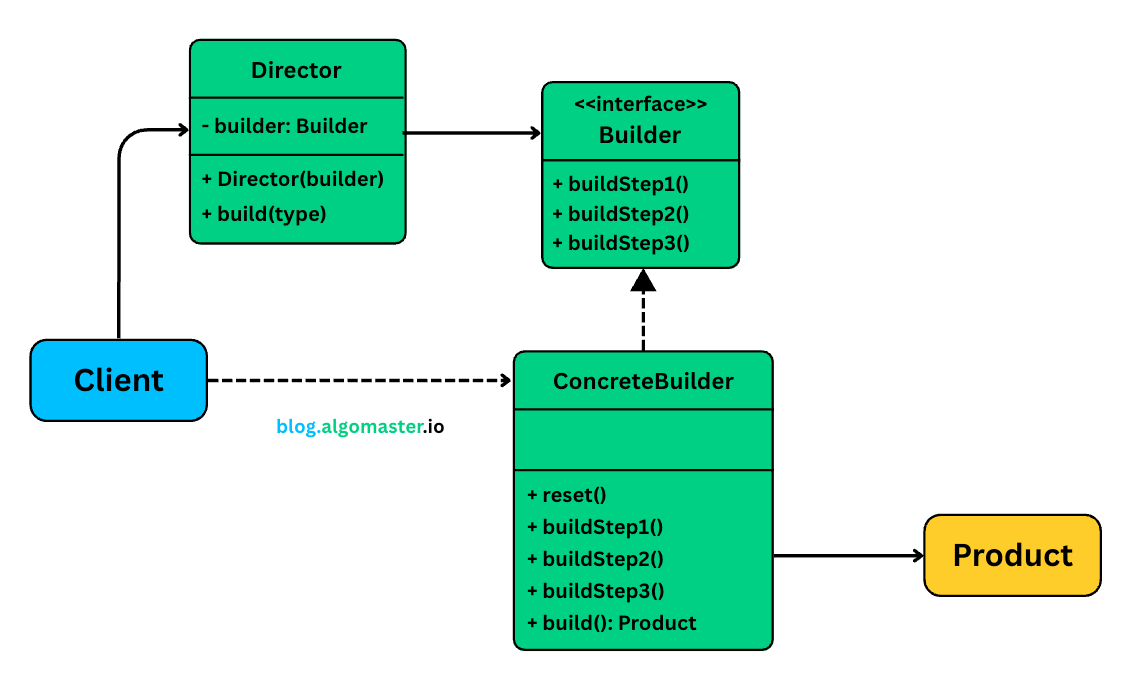Builder Pattern
- It is a creational design pattern that lets you construct complex objects step-by-step, separating the construction logic from the final representation.
Useful in situations
- An object requires many optional fields, and not all of them are needed every time.
- You want to avoid telescoping constructors or large constructors with multiple parameters.
- The object construction process involves multiple steps that need to happen in a particular order.
Initial problem we have
- We are building a system to configure the HTTP requests. Each request is mix of some fields where some are required and some are totally optional. like
- url (required)
- method (require)
- headers (optional)
- body (optiona)
- ....so on
- There are two naive approach to build this is to use constructor overloading or telescoping constructor pattern
Constructor overloading
Each constructor has different sets of parameters, but they don’t chain, leading to repetition.
class HttpRequest {
String url;
String method;
Map<String, String> headers;
Map<String, String> queryParams;
String body;
int timeout;
// Constructor with only URL and method
public HttpRequest(String url, String method) {
this.url = url;
this.method = method;
this.headers = new HashMap<>();
this.queryParams = new HashMap<>();
this.body = "";
this.timeout = 0;
}
// Constructor with URL, method, and headers
public HttpRequest(String url, String method, Map<String, String> headers) {
this(url, method); // This could be chained, but here it's a copy
this.headers = headers;
}
// Constructor with all fields
public HttpRequest(String url, String method, Map<String, String> headers,
Map<String, String> queryParams, String body, int timeout) {
this.url = url;
this.method = method;
this.headers = headers;
this.queryParams = queryParams;
this.body = body;
this.timeout = timeout;
}
}
Telescoping Constructor pattern
Each constructor calls another, chaining parameters — becomes unreadable with many parameters.
class HttpRequest {
String url;
String method;
Map<String, String> headers;
Map<String, String> queryParams;
String body;
int timeout;
public HttpRequest(String url, String method) {
this(url, method, new HashMap<>());
}
public HttpRequest(String url, String method, Map<String, String> headers) {
this(url, method, headers, new HashMap<>());
}
public HttpRequest(String url, String method, Map<String, String> headers,
Map<String, String> queryParams) {
this(url, method, headers, queryParams, "", 0);
}
public HttpRequest(String url, String method, Map<String, String> headers,
Map<String, String> queryParams, String body, int timeout) {
this.url = url;
this.method = method;
this.headers = headers;
this.queryParams = queryParams;
this.body = body;
this.timeout = timeout;
}
}
- In above approach we have to remeber full order and pass default values when ever we use it and it has other issue as well like
- hard to read and write
- Inflexible as if you want to set parameter 5 but not 3 and 4, you’re forced to pass null for 3 and 4.
- Adding a new parameter is hard
Builder Pattern
- The Builder pattern separates the construction of a complex object from its representation
Class diagram

-
Builder (e.g., HttpRequestBuilder)
- Defines methods to configure or set up the product.
- Typically returns
thisfrom each method to support a fluent interface. - Often implemented as a static nested class inside the product class.
-
ConcreteBuilder (e.g., StandardHttpRequestBuilder)
- Implements the Builder interface or defines the fluent methods directly.
- Maintains state for each part of the product being built.
- Implements the
build()method that returns the final product instance.
-
Product (e.g., HttpRequest)
- The final object being constructed.
- May be immutable and built only via the Builder.
- Has a private constructor that takes in the builder’s internal state.
-
Director (Optional) (e.g., HttpRequestDirector)
- Orchestrates the building process using the builder.
- Useful when you want to encapsulate standard configurations or reusable construction sequences.
- In modern usage (especially in Java with fluent builders), the Director is often omitted, and the client takes on this role by chaining methods.
Implementing Builder
Create Product Class
class HttpRequest {
private final String url;
private final String method;
private final Map<String, String> headers;
private final Map<String, String> queryParams;
private final String body;
private final int timeout;
// private called by builder
private HttpRequest(Builder builder) {
this.url = builder.url;
this.method = builder.method;
this.headers = builder.headers;
this.queryParams = builder.queryParams;
this.body = builder.body;
this.timeout = builder.timeout;
}
public static class Builder {
private String url;
private String method;
private Map<String, String> headers = new HashMap<>();
private Map<String, String> queryParams = new HashMap<>();
private String body = "";
private int timeout = 0;
public Builder setUrl(String url) {
this.url = url;
return this;
}
public Builder setMethod(String method) {
this.method = method;
return this;
}
public Builder setHeaders(Map<String, String> headers) {
this.headers = headers;
return this;
}
public Builder setQueryParams(Map<String, String> queryParams) {
this.queryParams = queryParams;
return this;
}
public Builder setBody(String body) {
this.body = body;
return this;
}
public Builder setTimeout(int timeout) {
this.timeout = timeout;
return this;
}
public HttpRequest build() {
return new HttpRequest(this);
}
}
}
Using on client side
HttpRequest request = new HttpRequest.Builder()
.setUrl("https://api.example.com")
.setMethod("POST")
.setHeaders(Map.of("Authorization", "Bearer token"))
.setBody("{\"key\":\"value\"}")
.setTimeout(5000)
.build();
Benefits
- Avoids telescoping constructors and improves readability.
- Makes object construction flexible and clear.
- Can enforce immutability and validation before object creation.
When to Use
- When an object has many optional parameters.
- When you want to make the construction process readable and maintainable.
- When you want to enforce certain construction steps or validation.